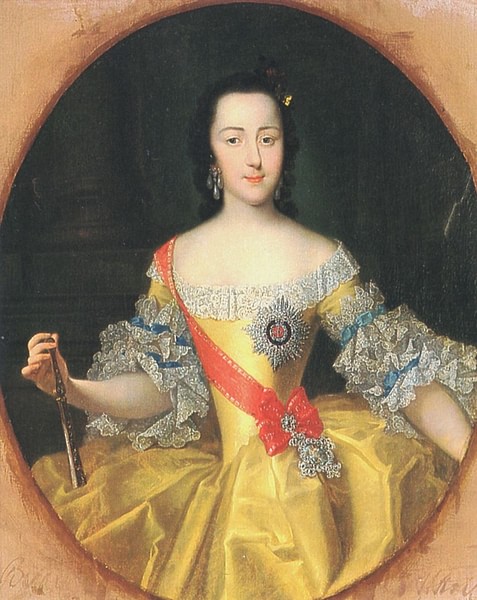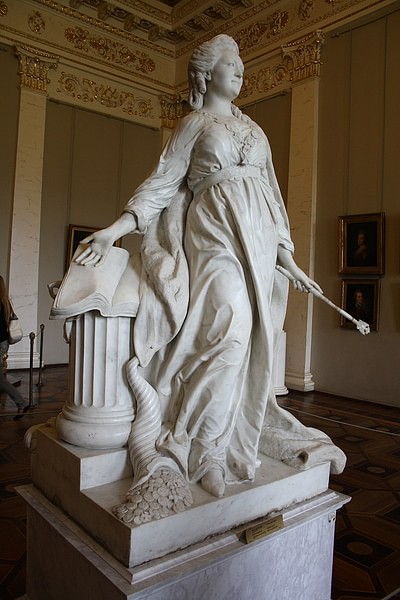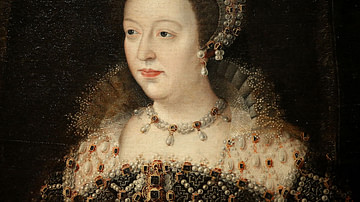Catherine II of Russia (Catherine the Great) was the empress regent of Russia from 1762 to 1796. During the mid-18th century, Russia was still regarded as culturally behind compared to Western European countries. However, during her reign, Catherine transformed Russia into a global power.
Like her grandfather-in-law, Peter I of Russia (Peter the Great, r. 1682-1725), Catherine was inspired by Western European culture and way of life. Under her rule, Russia experienced a cultural renaissance.

Catherine & the Enlightenment
In the 18th century, French was considered the language of art, culture, and academia, and so Catherine's governess ensured that French became her second language. Catherine had read many books about the European Enlightenment (1685-1815). She was especially inspired by the French writer and philosopher Voltaire (l. 1694-1778). Voltaire was interested in Russia but was unsure about Catherine being empress. He soon viewed Catherine as an enlightened monarch, and they began to correspond with one another until Voltaire's death in 1778. They saw eye-to-eye on political points and agreed that a ruling class was the only form of government that made rational sense.
Another Enlightenment figure that Catherine became close to was the French philosopher Denis Diderot (l. 1713-1784). Diderot was the head editor of the Encyclopedia, the book of the enlightened, however, he was stripped of his editing rights due to coming in conflict with the Catholic Church. Catherine was aware of these difficulties with the Encyclopedia and offered to have it published in Russia. The editors were wary about entrusting Catherine with their work, and the French government soon reinstated the publishing rights in France.
Catherine found another way to help Diderot after his fourth child was born. Since he had no money, he decided to sell his library. Catherine offered to buy his books, but only under the condition that the books must remain with him until his death. In that way, Diderot became the librarian of Catherine. Catherine had a secret motive for buying Diderot's books; she showed that Russia was invested in culture. In return for her generosity, Diderot hired writers, artists, engineers and scientists on her behalf and sent them to St. Petersburg.
Diderot travelled to Russia in 1773 and met with Catherine. As an editor of the Encyclopedia, Diderot believed it was his duty to give Catherine advice on how to rule Russia. He encouraged her to reform Russia while still alive and adopt an English-style government. Catherine thanked him for his guidance but told him that he did not understand the reality of Russia.
The Nakaz
Catherine's Nakaz (Instruction) was a revision of the Russian legal code. Its full title was Instruction of Her Imperial Majesty Catherine the Second for the Commission Charged with Preparing a Project of a New Code of Laws. Catherine considered this new legal code her greatest contribution to Russia. She worked daily on it for two years, and it was finally published on 30 July 1767. She hoped that the Nakaz would usher in a new age of tolerance and justice in the Russian Empire, inspired by the Age of Enlightenment.
Before Catherine had come to the throne, the administration of the Russian government was all over the place due to various rulers implementing different laws that contradicted each other. Half of Peter I's reforms were never recorded and were lost to history. Catherine knew it was her job to restore Peter I's vision for Russia.

The Nakaz consisted of 526 articles split into 20 chapters, presenting Catherine's view of the Russian state and how she thought it should be governed. Catherine hoped that the Nakaz would transform Russia into a more culturally sophisticated and politically advanced country. Although that ultimately did not happen, once the Nakaz was widely published and translated into different languages, people viewed Catherine with great admiration.
The Legislative Commission
The second part of the Nakaz that Catherine put into action was gathering together delegates from all walks of life across Russia. This delegation would inform Catherine about their hopes, needs, and issues, which would assist her in putting together a new code of laws. Altogether, there were 564 delegates who were all paid a salary and freed from any punishment. The Legislative Commission met in Moscow. On 30 July 1767, Catherine rode through the streets of Moscow to the Kremlin in a gilded carriage. After a church ceremony, the delegates were presented to her in the Palace of Facets.
Over several days, the vice-chancellor, Prince Alexander Golitsyn (l. 1773-1844), read the Nakaz aloud to the delegation. Each delegate brought with them a list of complaints and petitions - many were trivial, while others contained reasonable grounds for reform. Nonetheless, Catherine had succeeded in bringing together representatives of the Russian population to discuss their problems and dreams freely.
After five months in Moscow, Catherine decided to move the commission to St. Petersburg in February of 1768. There, the nobles expressed their desire to have more power in local governments and to enter the industrial and commercial sectors. The nobility who had descended from powerful, wealthy families also demanded a clear distinction be made between the old heredity nobility and the newer class of nobles.
A hot topic at the assembly was the topic of serfdom, with there being two clear sides – the supporters of serfdom and those who opposed it. Despite Catherine's growing dislike of the idea of serfdom, the strong, passionate reaction of the nobles caused her to back down to avoid confrontation. She was well aware that the success of her reign depended largely on the nobility.
The commission lasted 18 months, yet no new law was created during that time. However, the information provided was valuable and proved to Catherine that Russia's stability depended on keeping the absolute authority of the monarch.
Local Administration Reforms
On 17 March 1775, Catherine released a manifesto to celebrate the end of the Russo-Turkish War (1768-1774). In this manifesto, she cancelled the special taxes that were imposed to help fund the war, and she offered amnesty to all criminals, deserters and runaways. Ever since the failed Legislative Commission, Catherine had been working behind the scenes on the issue of local administration. She spoke to advisors, including a Baltic noble, Count Jacob Sievers (l. 1731-1808) and Prince A. A. Vyazemsky (l. 1727-1793), the Procurator-General, and studied the administration of the Russian Baltic provinces, which was based on the German model.
On 2 November 1775, the new statute for the Administration of the Provinces of the Russian Empire was published. It covered the decentralisation of the courts of law and administrative offices and the establishment of separate offices for finance, justice and administrative matters. Different governing bodies were also formed to deal with the concerns of the townspeople, merchants, nobles, and peasants. The 25 provinces were split into 40 regions, with each having 300,000-400,000 people, which were further divided into areas of 20,000-30,000 people. This meant that administrative offices were within a day's ride of each town or village. A governor, assisted by a board, oversaw the administration, and a deputy governor was in charge of taxes and finances.

Legal & Penal System Reforms
The governor oversaw a system of different law courts: the main civil and criminal courts, an upper, a district and a lower land court for the nobility, a magistrat (upper and district court) for the townspeople and a higher and lower summary court for the peasants. A Court of Conscience was also set up in each district. This court dealt with cases of all classes, including sexual offences, witchcraft, and lunacy. Policing duties were given to the town provost, who oversaw a small group of armed men. A land commissar functioned like a Justice of the Peace. Boards of social welfare oversaw the welfare of the citizens. They were run by a governor and accessors from the different courts. These boards set up schools at provincial and district levels, hospitals, workhouses, houses of correction, and almshouses.
In 1782, the Police Ordinance was established. It outlined the regulations for the policing of towns and the laws for criminal and civil crimes. Provinces were split into wards, which were overseen by the town provost and a police group. The provost and his police were responsible for general public order, hygiene, morals, fire prevention, the labour market, distribution of food, and theft of goods.
Catherine modernised the Russian penal system by creating prisons where prisoners stayed before being tried and setting up houses of correction for people who committed petty crimes. Catherine ordered that men and women were to be kept separate in prisons, as were the convicted and those who had not been tried yet. If any prisoners rebelled against the prison rules, they were confined in a punishment cell. However, there was no mention of corporal punishment. Catherine believed that it was better for a crime to be prevented rather than punished. She condemned torture and wanted forms of punishment to suit the severity of crimes committed; for example, people who vandalised or destroyed property should have their property taken off them. She stated that some judges should be of equal social standing to the defendant so that hearings could be more fair.
Social & Medical Reforms
Boards of social welfare were set up and were the first genuine attempt at a social welfare system. Each board was given 15,000 rubles and relied on donations from the local nobility and merchants. These boards were put in charge of hospitals, prisons, houses of correction, and workhouses for the poor.
The plague epidemic that spread through Moscow in 1771 made it clear that medical institutions were needed in every town. As written in the Statute of 1775, each province was required to have a doctor, a surgeon, apprentices, surgeon assistants, and an apothecary. In 1767, a hospital was built in Moscow, and another one, named after Catherine, was built in 1775. Catherine laid out strict guidelines for these hospitals: the rooms needed to have fresh air, the bed sheets needed to be kept clean, and bells and water jugs needed to be kept at each bedside.

Religious Reforms
Although Catherine had converted to Russian Orthodoxy, she was not particularly religious herself. Yet, Catherine suppressed any protests against the church and promoted Christianity. She offered monetary rewards for people who converted to the Russian Orthodox Church. She introduced the Toleration of Faiths Edict in 1773, which allowed Muslims to build mosques and freely practice their religion. Catherine treated Judaism as a separate legal and administrative system. In 1782, she implemented the Charter of the Towns, which saw the Jewish population treated as equals to the Orthodox Christians. Religious education was reviewed, and by 1786, Catherine had removed religion from the state education system. Catherine began to secularise the day-to-day operations of the state. Catherine's view towards religion could be interpreted as a secular one. Although she could not fully turn her back on religion, she also fought against being constrained by it.
Economic Reforms
To modernise and revitalise the Russian economy, Catherine invited German farmers to immigrate to the Volga River Valley. These German farmers brought with them many innovations, including wheat production, sheep raising, flour milling, and tobacco production. These innovations caused the Volga River Valley to have a thriving economy.
During Catherine's reign, the first paper money was issued under the Assignation Bank, which opened in 1769. These notes were called Assignation rubles and slowly replaced copper coins. These notes were in use until 1849.
Educational Reforms
Catherine firmly believed that all Russian children should have a European education. She appointed Ivan Betskoy (l. 1704-1795) as her Educational Reformer, whose job was to compare the Russian educational system with European ones. An Educational Commission was formed with British educational pioneers Reverand Daniel Dumaresq (l. 1712-1804) and Dr John Brown (l. 1715-1766) taking part. The Educational Commission was tasked with forming an educational system for Russian Orthodox students between the ages of five and 18 years old.
The Moscow Foundling Home was founded to educate lower-class and illegitimate children. However, it ultimately failed due to high mortality rates. Catherine then established the Smolny Institute for Noble Girls – the first all-girls school in Russia. The school eventually accepted daughters of the nobility and the bourgeoisie, who were taught music, French, and dance. The Cadet Corps was completely remodelled in 1766, with philosophy, science, history, ethics, and international law added to the curriculum.
A Commission of National Schools was formed under the statesman Pyotr Zavadovsky (l. 1739-1812). The commission was tasked with translating textbooks and making a guidebook for teachers. The Russian Statute of National Education was established on 5 August 1786. It created a two-tier system of primary and high schools that were free and open to children of all classes except for the children of serfs.
Although Catherine put a lot of effort into reforming the Russian education system, she still faced criticism for not investing enough money in educational programs. By the end of her reign, only around 62,000 students were being educated across Russia. She also failed to provide education for the peasants, which many historians agree caused her to fall short of fully reforming the educational system.
Serfdom
Serfs were peasants who gave up their freedom to a landowner in exchange for security and protection during hardship. In Russia, serfdom existed long before Catherine's birth and was an integral part of Russian society when Catherine came to the throne. Yet, Catherine felt inspired to make some changes. She gave the serfs the right to file complaints against landowners, thus giving them a bureaucratic status, a voice, and a right to be freed if they were under illegal ownership. Once a serf had been freed, she made it impossible for them to become serfs once again. On the other hand, she had removed an act put in place by Peter I that freed any serfs who belonged to the Russian Orthodox Church.
Although Catherine had made some improvements to the conditions of the serfs, she was wary of making too many radical changes, and the serfs remained unhappy during her reign. Her reforms revolving around serfdom and peasants did not reflect the modern way of thinking reflected in her other reforms.
Catherine & the Arts
Catherine was incredibly passionate about the arts, including literature, painting, and philosophy. She was not only a consumer of the arts, but she also took an active part in it and wrote her own comedies and memoirs, which were admired by Voltaire and Diderot. Catherine founded the Hermitage Museum in St. Petersburg in 1764, which celebrates its founding on 7 December each year (St. Catherine's Day). Catherine was also responsible for reforming the Imperial Academy of Arts, which oversaw all issues relating to the arts.
Catherine established the Imperial Russian Library (lovingly called "Catherine's Library"). It was located near the Winter Palace and housed entire libraries of notable people, including Italian archaeologist Berardo Galiani (l. 1724-1774) and French mathematician Jean Le Rond d'Alembert (l. 1717-1783). Catherine especially loved collecting books on art and architecture, and her collection of artwork would inspire building commissions, including Chesme Palace in St. Petersburg and the Raphael Loggia in the Hermitage Museum.

Catherine's reign saw the rise of the Russian intelligentsia, where more Russian citizens attended universities, learnt foreign languages, travelled, and wrote stories and plays. They were no doubt inspired by their cultured and educated empress.
Legacy of Catherine's Reforms
Catherine's role as empress of the Russian empire was a huge feat, especially considering that she was not Russian by birth and married into the Russian royal family. Although not all her reforms were as successful as she had hoped they would be, she made huge strides in transforming the very fabric of Russian society, including the monumental tasks of modernising the educational system and the Russian administration.
Under her rule, Russia saw the Golden Age of Enlightenment, and Catherine followed in the footsteps of her grandfather-in-law, Peter the Great, in modernising Russia and putting it on equal footing with other European nations. Looking at all that she achieved during her long reign, it's easy to see why she earned the title of Catherine the Great.










